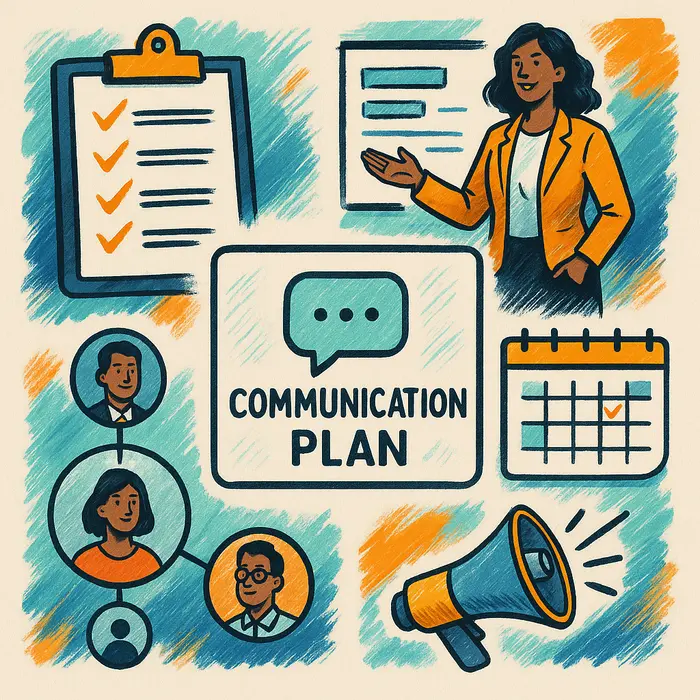Most communication plans look great in the kickoff deck—and then no one touches them again.
The problem? They’re often too vague, too complex, or just not tailored to how people actually work.
A good communication plan isn’t a formality—it’s a living guide for who needs what information, when, how, and why. Done right, it keeps your project humming, your stakeholders aligned, and your team out of confusion and chaos.
Here’s how to create a communication plan people actually use.
What Is a Communication Plan?
A communication plan is a simple document that outlines:
Who needs to know what
What information they need
When they need it
How you’ll deliver it
Why it matters to them
It helps reduce surprises, clarify expectations, and improve transparency across all levels of a project or initiative.
Why Most Communication Plans Fail
Common reasons:
Too generic or boilerplate
Doesn’t reflect actual communication habits
Overloads people with unnecessary updates
Doesn’t evolve with the project
Isn’t accessible or referenced regularly
What Makes a Communication Plan Useful?
A good plan:
Focuses on value, not volume
Is tailored to real stakeholders and channels
Sets clear expectations for cadence and format
Is visible, revisited, and adjusted as needed
How to Build a Communication Plan (Step-by-Step)
Step 1: Identify Your Stakeholders
Start with a quick stakeholder map. Think beyond execs:
Project sponsors
End users
Department leads
Support teams
Vendors or external partners
Map them by interest and influence so you know who needs what level of detail.
Step 2: Clarify What Each Stakeholder Group Needs
Ask:
What do they care about?
How often do they want updates?
What format works best (email, Slack, dashboard, calls)?
What decisions or feedback are they responsible for?
Use this to segment your communication—not everyone needs the same info.
Step 3: Choose Your Channels and Cadence
List out your tools and rhythms:
Weekly team stand-ups (Slack/Zoom)
Biweekly steering committee updates (email summary or deck)
Monthly dashboards or metrics reports
Ad hoc alerts for blockers or scope changes
Keep it realistic—use channels people are already active in.
Step 4: Document It Simply
Create a clear table like this:
| Audience | Info Needed | Format | Frequency | Owner |
|---|---|---|---|---|
| Exec Sponsor | High-level progress, risks | Email or slide deck | Monthly | PM |
| Project Team | Tasks, blockers, decisions | Daily stand-up | Daily | Scrum Master |
| Support Team | Go-live dates, user impacts | Slack + FAQ doc | As needed | BA |
You can add a “Purpose” column too, to show why each line matters.
Step 5: Share It—and Keep It Visible
Add it to your kickoff materials
Pin it in your project folder or collaboration tool
Review it during retrospectives or check-ins
Step 6: Adjust as You Go
As stakeholders change, scope evolves, or preferences shift—update the plan. Treat it like a living document, not a contract.
Tips for Making It Stick
Be consistent: Don’t say “weekly update” and then skip it.
Be concise: Stick to what matters for each audience.
Visuals help: Dashboards, status lights, timelines beat long emails.
Create templates: Standardize formats for weekly updates or risk logs.
Track feedback: Ask stakeholders if they’re getting what they need—or too much.
Final Takeaway
A good communication plan doesn’t just keep people informed—it keeps them engaged, aligned, and confident in the project’s direction.
“The best communication plan is the one that actually gets used.”
So skip the overkill. Focus on clarity, consistency, and care—and you’ll avoid most of the misalignment, confusion, and surprises that derail projects.
Start small. Build something real. Then make it better as you go.
Related Posts
- Waterfall vs Agile: Which Project Management Method Is Right for You?
- How to Kick Off a Project with Confidence
- Creating a Requirements Traceability Matrix (RTM): A Step-by-Step Guide
- Stakeholder Analysis: Know Who to Engage and How
- Business Rules vs. Functional Requirements: What’s the Difference and Why It Matters
